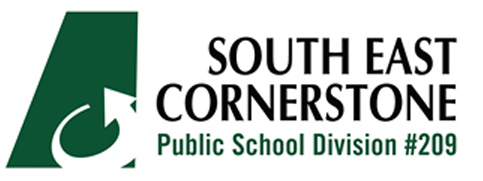By Norm Park, SE Cornerstone
A presentation on the use of technology to benefit the students of the Southeast Cornerstone Public School Division included the use of robotic technology. Grant Taylor, instructional technology consultant, arrived at the meeting via robotics, making a brief wheeling appearance in front of the board as part of the presentation along with Jeff Walters, instructional technology coordinator.
“We take what the teachers and students are doing with their curriculum and work with them,” said Walters, at the board’s monthly business session on Wednesday, updating the trustees on the progress being made on the technology fronts as they pertain to classroom instructions.
This is his first year as co-ordinator of the instructional technology branch of the public education system. The team consists of Walters, and Taylor, a Carlyle-based educator and consultant. There used to be four members on the team but due to recent cuts to education funding, that base has now been reduced to two. That has not slowed the progress in programming though, Walters explained.
Taylor made his appearance before the board through the wonders of online imaging and robotics, wheeling his image into the conference room via a rolling robot. He explained this was just part of the new age of technology that is enhancing the learning experiences for students throughout the division.
“We are building capacity in the schools,” said Walters in the early part of the presentation, noting that in most of the schools now, even the small facilities, there is usually “a tech person others can go to for support and technical glitch problem solving. We are finding these people and we use them to help us provide services and support in the school. This will be a two-way street to exchange best practices and will ultimately help the teacher(s) with professional development.”
Solving technical problems in-house is a genuine cost-saving measure and one that is encouraged by the instructional technology team that was halved in size heading into this academic year. The programming trains new teachers with electronic grade books, division services and other educational technology practices, Walters said. He added that the instructional technology position is different from an information system, or tech help desk person. I.T. supports educational technology applications.
Interest in program coding is growing quickly within the system and Walters added that while it is not embedded in the curriculum yet, “it overarches it.”
He provided an example of reaching beyond curriculum requirements where a group of Estevan Comprehensive School students used a virtual reality program to visit Greece. He said collaboration efforts like that “does not get in the way of the teachers.”
Coding Quest programs are now a regular feature for students in Grades 4 to 6, he noted. There are 44 teachers in the division within 21 schools (those that offer high school programming) who are involved in the read and write technology services. Technology has also improved efficiencies insofar as there are fewer occasions when teams have to travel to exchange ideas. These matters can now be handled through online conferences.
It was noted during the presentation that enrolment in the division’s Cyberstone online schooling, offered to students from Grades 8 to 12, is now 520. There is also an e-library for instructional technology and the mandate across the province now is to seek a unified student information system, which could become a step closer, as soon as next month, Walters said.
Walters wrapped up the presentation by noting the 21st Century skills needed included the four Cs. “That is communication, collaboration, critical thinking and some creativity,” he said.
He enhanced the presentation by bringing to the table supporting information regarding learning highlights in assistive technology, participation numbers on the Coding Quest program, professional development initiatives, and the resources available through the e-library.




